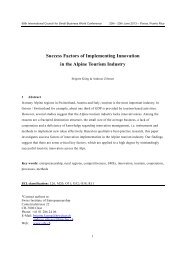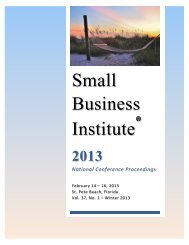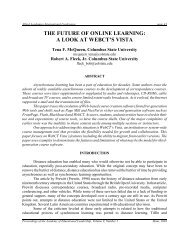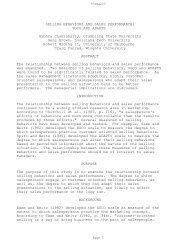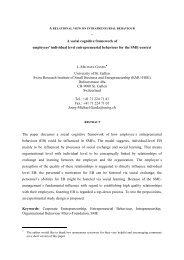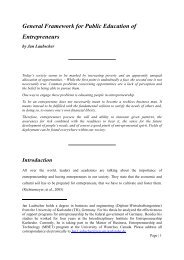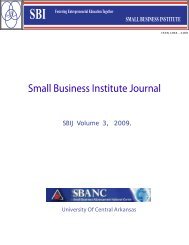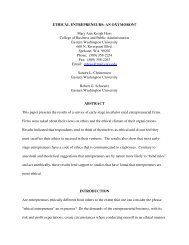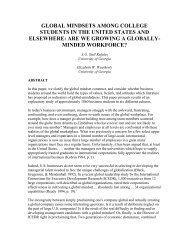Entrepreneurializing the Organization: Archetypes of Commitment to ...
Entrepreneurializing the Organization: Archetypes of Commitment to ...
Entrepreneurializing the Organization: Archetypes of Commitment to ...
You also want an ePaper? Increase the reach of your titles
YUMPU automatically turns print PDFs into web optimized ePapers that Google loves.
<strong>Entrepreneurializing</strong> <strong>the</strong> <strong>Organization</strong>: <strong>Archetypes</strong> <strong>of</strong> <strong>Commitment</strong> <strong>to</strong><br />
Corporate Entrepreneurship and Implications for Strategic<br />
Entrepreneurship<br />
Theodore T. Herbert and Deborah V. Brazeal<br />
Abstract<br />
Institutionalizing entrepreneurship within <strong>the</strong> corporation can be an effective means by which <strong>to</strong> gain competitive<br />
advantage. Yet <strong>the</strong>re are many approaches by which this can be done. We propose four archetypes which represent<br />
gradations <strong>of</strong> commitment <strong>to</strong> corporate entrepreneurship and discuss <strong>the</strong>ir various attributes and potential for<br />
gaining sustainable competitive advantage. The linkage between <strong>the</strong>se archetypes and <strong>the</strong>ir "fits" (Miller, 1983)<br />
with <strong>the</strong> strategic and competitive postures <strong>of</strong> <strong>the</strong> firm is explored as a crucial and initiating point for corporate<br />
entrepreneurship programs. The traditional role <strong>of</strong> <strong>the</strong> <strong>to</strong>p management team is re-defined in formulating a strategy<br />
for innovativeness.<br />
Introduction<br />
In response <strong>to</strong> <strong>the</strong> rapid rate <strong>of</strong> change in competition and <strong>the</strong> pressures <strong>of</strong> technological advances, corporate<br />
executives are unanimous in <strong>the</strong>ir stated desire <strong>to</strong> make <strong>the</strong>ir employees and <strong>the</strong>ir organizations more<br />
"entrepreneurial". The traditional view has been that this is accomplished through individual creative people and,<br />
more recently, teams <strong>of</strong> individual creative people. Consequently, <strong>the</strong> stereotypical "entrepreneurial" organization<br />
has been seen less as an organization in which innovativeness is an embedded part <strong>of</strong> <strong>the</strong> organization's process and<br />
structure, and more <strong>the</strong> "place" within which (a) innovations have been developed, (b) innovative people happen <strong>to</strong><br />
reside and work, and (c) whose controls are capable <strong>of</strong> being overcome so that <strong>to</strong>p management can reluctantly<br />
agree <strong>to</strong> accept <strong>the</strong> innovation. Corporate executives <strong>the</strong>n seek <strong>to</strong> find means by which <strong>to</strong> unleash <strong>the</strong> creative<br />
talents <strong>of</strong> <strong>the</strong>ir people and <strong>to</strong> lower <strong>the</strong> built-in barriers <strong>to</strong> new ideas that could bubble up from <strong>the</strong> depths <strong>of</strong> <strong>the</strong><br />
organization.<br />
On <strong>the</strong> short list <strong>of</strong> approaches that encourage <strong>the</strong> creativity that leads <strong>to</strong> pr<strong>of</strong>itable innovations is <strong>to</strong> inundate<br />
marketing people and scientists (or o<strong>the</strong>r "creatively-inclined" people such as knowledge workers) with<br />
exhortations <strong>to</strong> "think outside <strong>the</strong> box", <strong>to</strong> think "sidewise" about problems, and <strong>to</strong> "network" with o<strong>the</strong>rs with<br />
different perspectives. Ano<strong>the</strong>r approach is <strong>to</strong> <strong>of</strong>fer rewards and recognition's <strong>to</strong> successful innova<strong>to</strong>rs. Too,<br />
supervisors and o<strong>the</strong>r gatekeepers are exhorted <strong>to</strong> be receptive <strong>to</strong> new ideas, <strong>to</strong> wink at and ignore time taken from<br />
assigned projects and applied <strong>to</strong> pet (although unauthorized) ideas. By-passes <strong>to</strong> bureaucratic procedures similarly<br />
are created for new ideas. And formal procedures may be established by which <strong>to</strong> winnow out and bless for fur<strong>the</strong>r<br />
development those project proposals which seem most likely <strong>to</strong> fit <strong>the</strong> needs for new product development<br />
schedules or have <strong>the</strong> potential <strong>to</strong> provide useful new directions for research or development. There is a wide range<br />
<strong>of</strong> corporate approaches <strong>to</strong> overcoming built-in barriers <strong>to</strong> creativity and innovation, and <strong>the</strong> approaches range<br />
widely in how well <strong>the</strong>y work.
A listing <strong>of</strong> all <strong>the</strong> various techniques employed <strong>to</strong> encourage creativity in organizational settings would fill a book<br />
(for a partial listing and discussion, see Herbert & Brazeal, 1998). A great deal <strong>of</strong> importance and attention has<br />
been given, appropriately enough, <strong>to</strong> <strong>the</strong> need <strong>to</strong> enhance innovation in organizations. At <strong>the</strong> same time, <strong>the</strong> study<br />
and application <strong>of</strong> Corporate Entrepreneurship has been developing in encouraging directions and rates. We <strong>the</strong>n<br />
feel that <strong>the</strong>re may be some utility in considering <strong>the</strong> relative effectiveness <strong>of</strong> corporate efforts <strong>to</strong> enhance <strong>the</strong>ir<br />
innovativeness, adopting a contingency approach <strong>of</strong> exploring <strong>the</strong> conditions under which such efforts are<br />
differentially appropriate or differentially effective. We also believe <strong>the</strong>re <strong>to</strong> be some usefulness <strong>to</strong> be gained by<br />
framing and understanding patterns <strong>of</strong> entrepreneurial devices and entrepreneurship-enhancing methods. These<br />
patterns <strong>of</strong> practice can be, we believe, stipulated and organized by considering <strong>the</strong>m as a finite number <strong>of</strong><br />
archetypes or models <strong>of</strong> common practice. Our paper makes that attempt.<br />
Entrepreneurship and <strong>the</strong> <strong>Organization</strong><br />
Making a corporation more creative, more innovative, more entrepreneurial has gone from being a nicety or a<br />
slogan; it is now a minimum requirement in many industries simply <strong>to</strong> stay in <strong>the</strong> competitive game. Since it has<br />
become a challenge taken more seriously than ever before, <strong>the</strong> question <strong>of</strong> how <strong>to</strong> do it has become one asked in<br />
deadly earnestness. And, in fact, <strong>the</strong> notion <strong>of</strong> introducing entrepreneurship within <strong>the</strong> established organization is<br />
even more complicated than it might seem. The complication is two-fold.<br />
First, while <strong>the</strong>re are similarities between <strong>the</strong> two, (individual) entrepreneurship and corporate entrepreneurship are<br />
very different, but ra<strong>the</strong>r rarely differentiated when one speaks <strong>of</strong> increasing <strong>the</strong> corporation's entrepreneurial<br />
potential. Indeed, <strong>the</strong> (unspoken) presumption is that increasing <strong>the</strong> entrepreneurial potential <strong>of</strong> (some <strong>of</strong>) <strong>the</strong><br />
corporation's employees is <strong>the</strong> same as increasing <strong>the</strong> entrepreneurial potential <strong>of</strong> <strong>the</strong> corporation as a whole. The<br />
classic conception <strong>of</strong> entrepreneurship is that <strong>of</strong> <strong>the</strong> individual, independent entrepreneur who assumes financial<br />
and o<strong>the</strong>r risks in order <strong>to</strong> exploit a new idea or product possibility; and that <strong>the</strong> risks <strong>of</strong> failure uniquely devolve<br />
upon <strong>the</strong> entrepreneur. In corporate entrepreneurship, however, individual or group entrepreneurship is fostered<br />
within a preexisting organizational setting; <strong>the</strong> organization provides support for <strong>the</strong> development and exploitation<br />
<strong>of</strong> one or more innovations which are deemed strategically and financially consistent with <strong>the</strong> supporting<br />
organization's mission. Thus, executives attempting <strong>to</strong> implant entrepreneurial activities, support for <strong>the</strong>m, and<br />
rewards for <strong>the</strong>m typically and by definition are interested in corporate entrepreneurship. Corporate executives are<br />
attempting <strong>to</strong> introduce new procedures by which <strong>to</strong> induce higher levels <strong>of</strong> innovation; higher levels <strong>of</strong><br />
innovativeness will yield, it is intended, greater market share, product-line extensions, technological dominance, or<br />
o<strong>the</strong>r pr<strong>of</strong>itability-related states. The conditions and intentions within spin-<strong>of</strong>fs, LBOs or MBOs (management buyouts),<br />
or o<strong>the</strong>r instances <strong>of</strong> similar nature are exceptions.<br />
The second complication stems from <strong>the</strong> functionality <strong>of</strong> entrepreneurship: Entrepreneurship for what? If <strong>the</strong> intent<br />
is <strong>to</strong> get burned-out employees <strong>to</strong> take more interest in <strong>the</strong>ir jobs by making suggestions on how <strong>to</strong> do <strong>the</strong>ir work<br />
better, <strong>the</strong>n <strong>the</strong>re will be a specific list or menu <strong>of</strong> focused programs (such as suggestion boxes, job re-engineering,<br />
"empowerment" programs, etc.) from which <strong>to</strong> choose. These entrepreneurial efforts will differ dramatically from<br />
those employed by <strong>the</strong> corporation for which <strong>the</strong> intent is <strong>to</strong> develop and introduce radical new means <strong>of</strong><br />
technological advances at all steps in its value chain, (Porter, 1980) in order <strong>to</strong> revolutionize its industry. The<br />
content <strong>of</strong> any entrepreneurial program is highly contingent on <strong>the</strong> purpose(s) sought, a point which should be<br />
ra<strong>the</strong>r obvious.
However, <strong>the</strong>re are those who prefer <strong>to</strong> (1) emphasize entrepreneurial activity as specific outcome-enhancer, (2)<br />
propose an organization-wide shift <strong>to</strong> an entrepreneurial culture, (3) focus on <strong>the</strong> attributes <strong>of</strong> <strong>the</strong> individual who<br />
displays entrepreneurial skills, or (4) opt for structural solutions <strong>to</strong> organizationally-sourced restrictions <strong>to</strong><br />
entrepreneurial activity, among o<strong>the</strong>rs. Each brings with it a very different set <strong>of</strong> prescriptions for accomplishing<br />
that perspective, as well as <strong>the</strong> potential breadth and depth <strong>of</strong> entrepreneurial behaviors and achievements. Some <strong>of</strong><br />
<strong>the</strong> means (Lengnick-Hall, 1992) by which <strong>the</strong> firm's internally-focused entrepreneurial activities can be undertaken<br />
are: through traditional R&D units (structural), through <strong>the</strong> efforts <strong>of</strong> individual employees or intrapreneurship<br />
(individual), or through units dedicated <strong>to</strong> <strong>the</strong> development <strong>of</strong> new products or technologies by internal ventures<br />
(structural outcome-enhancer). An additional vehicle is available through external means <strong>to</strong> achieve innovation,<br />
that <strong>of</strong> joint venture activities and acquisition, by which <strong>to</strong> import entrepreneurial talent or traditions. In o<strong>the</strong>r<br />
words, <strong>the</strong>re exist multiple means or venues <strong>to</strong> achieving <strong>the</strong> entrepreneurial spirit within <strong>to</strong>day's corporate form.<br />
Understanding <strong>the</strong>se two complications deeply leads <strong>to</strong> ano<strong>the</strong>r understanding. "Entrepreneurship" is not a unitary,<br />
monolithic consideration, but is ra<strong>the</strong>r a concept that covers a broad range or menu <strong>of</strong> activities and intentions. The<br />
activities undertaken should be a function <strong>of</strong> <strong>the</strong>ir intended purposes. The obvious (or at least <strong>the</strong> more commonly<br />
cited) purpose is <strong>to</strong> increase <strong>the</strong> innovation productivity <strong>of</strong> <strong>the</strong> corporation's employees.<br />
The strategic rationale for that purpose apparently is rarely articulated, however. Why is it important <strong>to</strong> increase <strong>the</strong><br />
innovation productivity or innovation potential? Is it <strong>to</strong> revive a moribund set <strong>of</strong> products? To solve long-standing<br />
inadequacies that have led <strong>to</strong> poor financial performance? To attract and retain crucial highly talented knowledge<br />
workers? To achieve a distinctive cost advantage at each stage <strong>of</strong> <strong>the</strong> firm's value chain? To find and provide<br />
competitive advantage in exceeding cus<strong>to</strong>mers' expectations through high value-added and premium prices?<br />
Each <strong>of</strong> <strong>the</strong>se alternative objectives have important strategic and competitive implications. Each determine (or at<br />
<strong>the</strong> least, suggests) <strong>the</strong> type <strong>of</strong> corporate entrepreneurship efforts <strong>to</strong> be undertaken. One notices that this insight<br />
implies strongly that <strong>the</strong> driving competitive strategy <strong>of</strong> <strong>the</strong> firm dictates <strong>the</strong> broad entrepreneurial nature <strong>of</strong> <strong>the</strong><br />
firm's efforts and those resources supportive <strong>of</strong> those efforts. In short, strategy and entrepreneurial efforts must "fit"<br />
(Miller, 1985) or be consistent with each o<strong>the</strong>r if corporate entrepreneurship is <strong>to</strong> succeed in any particular<br />
corporation.<br />
Note that this perspective is not entirely consistent with <strong>the</strong> corporate entrepreneurship literature, which tends <strong>to</strong><br />
emphasize an internal, process-oriented view <strong>of</strong> innovation. In scope and context, this literature seems <strong>to</strong> take as<br />
given (1) <strong>the</strong> externally-imposed (but generalized) necessity for innovation and (2) <strong>the</strong> organizational impetus (or<br />
<strong>the</strong> granting <strong>of</strong> slack) for <strong>the</strong> development <strong>of</strong> new initiatives. Specifically, individuals at non-executive levels<br />
realistically perceive that <strong>the</strong>ir organizational structural boundaries, <strong>the</strong> corporate culture, and current strategic<br />
priorities and directions are fixed, closed both <strong>to</strong> negotiation or <strong>to</strong> radically different interpretations o<strong>the</strong>r than those<br />
established by upper management. Thus, entrepreneurs embedded within <strong>the</strong> organizational layers are continually<br />
attempting <strong>to</strong> operate within (or despite) predefined organizational parameters. To innovate outside <strong>the</strong> strategic<br />
context or mission <strong>of</strong> <strong>the</strong> organization is not likely ever <strong>to</strong> gain <strong>to</strong>p management approval or resources; research and<br />
development, product development, and business development units are explicit organizational mechanisms<br />
normally given <strong>the</strong> assignment <strong>to</strong> ensure innovations or innovative programs in selected, strategically important<br />
areas. The innova<strong>to</strong>r, <strong>the</strong>n, must operate within organizational boundaries and processes which are (for all intents<br />
and purposes) fixed; it still may be possible <strong>to</strong> navigate <strong>the</strong> set boundaries, but probably not without difficulty.
Since discretion is a function <strong>of</strong> <strong>the</strong> member's authority level in <strong>the</strong> organization, in o<strong>the</strong>r words, forward-thinking<br />
<strong>to</strong>p management teams can and do actively perceive a broader range <strong>of</strong> alternatives which may also be riskier and<br />
more costly in nature. Simply put, individuals at lower organizational levels are more likely <strong>to</strong> limit innovations <strong>to</strong><br />
those <strong>of</strong> an incremental nature entirely within <strong>the</strong> strategic context <strong>of</strong> <strong>the</strong> organization; <strong>to</strong>p management teams have<br />
<strong>the</strong> authority <strong>to</strong> change strategic direction radically and, thus, perceive no internal limits <strong>to</strong> <strong>the</strong> kinds <strong>of</strong> innovations<br />
pursued. Entrepreneurship <strong>the</strong>n is a variable, not a fixed process or a constant -- except when it is explicitly defined<br />
<strong>to</strong> be so by higher authority.<br />
Entrepreneurship as a Strategic Variable<br />
In o<strong>the</strong>r words, <strong>the</strong> specific means by which "entrepreneurship" is implanted within a corporation and <strong>the</strong><br />
specification <strong>of</strong> <strong>the</strong> content <strong>of</strong> <strong>the</strong> "entrepreneurship" program depend on <strong>the</strong> firm's objectives and strategies. And if<br />
corporate entrepreneurship is strategic, <strong>the</strong>n its content should be <strong>the</strong> result <strong>of</strong> a process <strong>of</strong> strategic decisionmaking<br />
or formulation. The corporate entrepreneurship approach best suited <strong>to</strong> <strong>the</strong> corporation's competitive<br />
situation should be formulated as an explicit process by <strong>the</strong> corporation's <strong>to</strong>p management team ("TMT"), typically<br />
<strong>the</strong> <strong>to</strong>p two executive levels in <strong>the</strong> corporation, including <strong>the</strong> President/CEO (Hambrick & Mason, 1984). One<br />
reason for such an assignment <strong>of</strong> responsibility is that <strong>the</strong> decision involves organization-wide considerations.<br />
Ano<strong>the</strong>r is that <strong>the</strong> result requires a re-formulation <strong>of</strong> executive responsibilities and resources <strong>to</strong> implement <strong>the</strong> new<br />
strategy for entrepreneurship, no matter how minor or how far-reaching it may prove <strong>to</strong> be. The point is that <strong>the</strong><br />
decision for strategic entrepreneurship (Herbert & Brazeal, 1998) leads <strong>to</strong> resource re-allocations and <strong>to</strong>ugh<br />
decisions on where <strong>the</strong> future <strong>of</strong> <strong>the</strong> organization lies, and not upon mouthing pretty (but empty) words.<br />
Top Management's Role<br />
In fact, this recognition <strong>of</strong> <strong>the</strong> TMT's strategic role runs contrary <strong>to</strong> <strong>the</strong> his<strong>to</strong>rical view <strong>of</strong> senior executives'<br />
responsibilities in corporate applications <strong>of</strong> entrepreneurship. Heret<strong>of</strong>ore, <strong>the</strong> roles <strong>of</strong> <strong>the</strong> TMT have been viewed as<br />
strategy formulation, setting policy, and championing <strong>the</strong> status quo, i.e., as being <strong>the</strong> harsh evalua<strong>to</strong>r <strong>of</strong> new or<br />
provocative ideas from lower levels. The TMT has <strong>of</strong>ten been seen, <strong>the</strong>n, as a major stumbling block <strong>to</strong> innovative<br />
efforts, if not by direct involvement in obstructing new ideas, <strong>the</strong>n by <strong>the</strong> sin <strong>of</strong> apathy or by omitting <strong>the</strong><br />
establishing <strong>of</strong> processes and vehicles supportive <strong>of</strong> innovativeness.<br />
The traditional perception <strong>of</strong> <strong>the</strong> TMT at best has been as a collective facilita<strong>to</strong>r <strong>of</strong> entrepreneurial activities which<br />
are pursued at lower levels in <strong>the</strong> organizational structure.<br />
Yet strong executive leadership may prove <strong>to</strong> be a central fac<strong>to</strong>r by which <strong>to</strong> infuse <strong>the</strong> organizational context with<br />
opportunity-seeking values and cultural norms, since innovations created by lower level employees reside within<br />
<strong>the</strong> existing strategic context <strong>of</strong> <strong>the</strong> organization as defined by <strong>the</strong> TMT. The <strong>to</strong>p management team, however,<br />
views and has responsibility for <strong>the</strong> organization as an entity, ra<strong>the</strong>r than as an amalgam <strong>of</strong> isolated and technicallyspecialized<br />
sets <strong>of</strong> resources separated by departmental or project boundaries.<br />
Collectively, TMT members have <strong>the</strong> capability <strong>to</strong> initiate decisions and strategic directions that impact <strong>the</strong><br />
complete organization's operations. The TMT has almost absolute authority <strong>to</strong> redefine or reconceptualize <strong>the</strong><br />
organization's strategic context; <strong>to</strong> establish, reinforce, or extinguish entrepreneurial or more traditional cultural<br />
norms; <strong>to</strong> undertake significantly different strategic directions for <strong>the</strong> organization; or <strong>to</strong> commit resources <strong>to</strong><br />
untried or untested programs or strategic directions, such as expanding internationally. In fact, Barringer and<br />
Bluedorn (1996) found that <strong>the</strong> extent <strong>of</strong> corporate entrepreneurship was highly dependent on a variety <strong>of</strong> strategic<br />
management activities, such as environmental scanning, planning flexibility, broad locus <strong>of</strong> planning, and an<br />
emphasis on strategic controls.
Such an intimate intertwining <strong>of</strong> strategy, <strong>to</strong>p executives, and entrepreneurship is evocative <strong>of</strong> a need <strong>to</strong><br />
reconceptualize <strong>the</strong> relationship as that <strong>of</strong> "strategic entrepreneurship" (Herbert & Brazeal, 1998). The role <strong>of</strong> <strong>the</strong><br />
TMT as a direct participant or genera<strong>to</strong>r <strong>of</strong> innovations opens <strong>the</strong> door for more dramatic, radical innovations<br />
indicative <strong>of</strong> discontinuous changes and potentially industry-altering changes. The TMT must prove <strong>to</strong> be a major<br />
player in championing, managing, and transitioning <strong>the</strong> processes <strong>of</strong> change and innovation (Bantel & Jackson,<br />
1989). We think that this contextual and driving fac<strong>to</strong>r has <strong>the</strong> opportunity <strong>to</strong> identify and explain much <strong>of</strong><br />
corporate entrepreneurial conditions, processes, and outcomes, from <strong>the</strong> unique perspective <strong>of</strong> environment,<br />
competition, and strategy -- entrepreneurship as competitive advantage.<br />
Resultant States <strong>of</strong> Entrepreneurialism in Corporations<br />
If, as we have argued, TMT values, economic realities, and strategic considerations lead <strong>to</strong> varying degrees <strong>of</strong><br />
entrepreneurialism within organizations -- as an explicit outcome <strong>of</strong> strategic decision-making by <strong>to</strong>p executives --<br />
<strong>the</strong>n it should follow logically that <strong>the</strong>re exists no one condition <strong>of</strong> corporate entrepreneurship. Supportive <strong>of</strong> <strong>the</strong><br />
concept is Covin and Slevin's (1989) suggesting a continuum along which firms may be arrayed, that <strong>of</strong><br />
conservativism-entrepreneurialism. Their "conservative" firm was risk-averse, noninnovative, and reactive, while<br />
"entrepreneurial" firms were risk-taking, innovative, and proactive; by implication, many different configurations<br />
lie between <strong>the</strong> two end points. Firms may be more entrepreneurial or less entrepreneurial, and may be identified<br />
and categorized according <strong>to</strong> some criterion. Building on <strong>the</strong> notion that definitive configurations <strong>of</strong> entrepreneurial<br />
orientation exist across corporations, we anticipate that some corporations will<br />
• remain staunchly un-entrepreneurial in <strong>the</strong>ir actions while preaching <strong>the</strong> virtues <strong>of</strong> being responsive and<br />
entrepreneurial,<br />
• o<strong>the</strong>rs will focus on fostering innovations in products or in processes,<br />
• ano<strong>the</strong>r set will seek <strong>to</strong> encourage <strong>the</strong>ir employees <strong>to</strong> submit new ideas <strong>to</strong> <strong>the</strong>ir hierarchical superiors for<br />
approval or implementation,<br />
• still o<strong>the</strong>rs will lurch <strong>to</strong>ward instilling an ongoing culture <strong>of</strong> entrepreneurship, and<br />
• a remainder will remain clueless as <strong>to</strong> what entrepreneurship is but will, with surprise and pleasure,<br />
welcome <strong>the</strong> random instances <strong>of</strong> innovative behaviors by employees (when <strong>the</strong>y don't contradict <strong>the</strong> biases<br />
<strong>of</strong> upper management or prove <strong>to</strong> be inconvenient <strong>to</strong> exploit).<br />
<strong>Archetypes</strong> <strong>of</strong> Entrepreneurialism in Corporations<br />
Thus, we suggest a range <strong>of</strong> outcome-configurations associated with <strong>the</strong> organization's orientation <strong>to</strong><br />
entrepreneurship, shown as Figure 1. The intent is <strong>to</strong> represent <strong>the</strong> different, systematic outcomes <strong>of</strong> <strong>to</strong>tality (or<br />
non-existence, or intermediate levels) <strong>of</strong> focus engendered within <strong>the</strong> organization on wide-ranging and deeplyengrained<br />
entrepreneurial activities. Each <strong>of</strong> <strong>the</strong> four is discussed below as an archetype, or model or pro<strong>to</strong>type,<br />
which is intended <strong>to</strong> capture its distinguishing characteristics.
Level <strong>of</strong><br />
<strong>Commitment</strong>:<br />
Figure 1 -- <strong>Archetypes</strong> as Gradations <strong>of</strong> <strong>Commitment</strong> <strong>to</strong><br />
Entrepreneurship within <strong>Organization</strong>s<br />
Non-existent Low Medium<br />
Total<br />
<strong>Commitment</strong><br />
Type <strong>of</strong><br />
<strong>Organization</strong>:<br />
The<br />
Entrepreneurially<br />
Challenged Firm<br />
The Accidentally<br />
Entrepreneurial<br />
<strong>Organization</strong><br />
The<br />
Entrepreneurially<br />
Oriented<br />
<strong>Organization</strong><br />
The<br />
Entrepreneurial<br />
<strong>Organization</strong><br />
The Entrepreneurially-Challenged Firm<br />
Anchoring <strong>the</strong> near end <strong>of</strong> <strong>the</strong> continuum is <strong>the</strong> Entrepreneurially-Challenged Firm, which is oblivious <strong>to</strong> <strong>the</strong><br />
concept <strong>of</strong> new methods or products/services, and which employs a culture <strong>of</strong> denial <strong>to</strong> any new idea or risk.<br />
Employees wishing <strong>to</strong> incrementally modify or improve even considerably outdated processes and procedures are<br />
shunned, punished financially and in o<strong>the</strong>r ways, and viewed as trouble-makers.<br />
Is this an effective archetype? Surprisingly, <strong>the</strong> answer is "Yes", but under very specific conditions. This type <strong>of</strong><br />
firm must exist in a placid, non-turbulent environment, with competitive protection such as having been granted a<br />
governmental monopoly and with little or no possibility <strong>of</strong> technological substitutes or advances. It must also have<br />
an internal structure and work process finely-tuned ei<strong>the</strong>r <strong>to</strong> efficiency or <strong>to</strong> lack <strong>of</strong> excesses which are guaranteed<br />
<strong>to</strong> alienate its governmental benefac<strong>to</strong>r. In this case, <strong>the</strong> strategy is that nothing is broken (no realistic challenges<br />
exist), and hence nothing needs <strong>to</strong> change. Is this realistic over <strong>the</strong> long term? Probably not. When <strong>the</strong> inevitable<br />
requirements for change, creativity, innovation, and adaptation occur, such an organization is highly vulnerable.<br />
But this "strategy" <strong>of</strong> being non-entrepreneurial does have a logic.<br />
The Entrepreneurial <strong>Organization</strong><br />
At <strong>the</strong> far end <strong>of</strong> <strong>the</strong> continuum, we suggest, is <strong>the</strong> archetype <strong>of</strong> <strong>the</strong> entire organization which is dedicated <strong>to</strong> and<br />
structured <strong>to</strong> facilitate <strong>the</strong> development, creation, and implementation <strong>of</strong> innovative processes, concepts, products,<br />
or services. This represents <strong>the</strong> emerging conceptualization <strong>of</strong> <strong>the</strong> Entrepreneurial <strong>Organization</strong>. <strong>Organization</strong>s<br />
which are "entrepreneurial" are those that have serious commitments <strong>to</strong> both incremental and radical innovations as<br />
strategically important <strong>to</strong> <strong>the</strong> competitiveness <strong>of</strong> <strong>the</strong> organization and tactically important <strong>to</strong> its operations and<br />
processes. Successful entrepreneurial organizations are able <strong>to</strong> produce a stream <strong>of</strong> innovations, systematically and<br />
consistently. This firm is likely <strong>to</strong> employ programs <strong>of</strong> Corporate Entrepreneurship, Intrapreneuring, or New<br />
Enterprise Venturing within <strong>the</strong> confines <strong>of</strong> <strong>the</strong> existing (traditional) corporate structure. Examples include <strong>the</strong> 3M<br />
Corporation (which introduced 500 new products in 1997 alone (O'Reilly, 1997) or o<strong>the</strong>r paragons <strong>of</strong><br />
institutionalized innovation, such as smaller s<strong>of</strong>tware companies, in which all employees, regardless <strong>of</strong> position,<br />
department, or rank, are expected (if not required) <strong>to</strong> spend a given percentage <strong>of</strong> <strong>the</strong>ir time working on projects <strong>of</strong><br />
<strong>the</strong>ir own undertaking, if not interest; some have formalized expectations <strong>of</strong> rates <strong>of</strong> new product introductions, for<br />
example, or <strong>of</strong> market share proportions between "old" and "new" products or services. Such firms do not limit<br />
<strong>the</strong>ir projects <strong>to</strong> product enhancements or cost-saving production engineering endeavors, but are likely <strong>to</strong> be found<br />
in o<strong>the</strong>r portions <strong>of</strong> <strong>the</strong>ir value chains, such as in <strong>the</strong> warehouse, logistics, evaluation procedures, and o<strong>the</strong>r<br />
fundamental business responsibilities.
For those organizations which have strategic intentions <strong>of</strong> developing, nurturing, and maintaining entrepreneuriallyoriented<br />
individuals and innovation-spawning processes and an internal environment <strong>of</strong> creativity, <strong>the</strong> involvement<br />
<strong>of</strong> <strong>to</strong>p management can be inferred when consistent innovation is observed in a firm. Implanting major<br />
entrepreneurial initiatives has been realistically noted as necessitating a massive structural overhaul <strong>of</strong> <strong>the</strong> current<br />
organizational system (Cooper, Willard, & Woo, 1986). Without <strong>the</strong> TMT's explicit and vigorous support, most<br />
organizations simply cannot make <strong>the</strong> significant and necessary changes demanded for flexible assignments, fluid<br />
structural arrangements, and personal responsiveness on a day-<strong>to</strong>-day basis in marketing, operations, finance, and<br />
development. By being proactive in <strong>the</strong> defining and establishing <strong>of</strong> appropriate conditions, <strong>the</strong> <strong>to</strong>p management<br />
team explicitly encourages <strong>the</strong> innovation process among interested parties through <strong>the</strong> building <strong>of</strong> an<br />
entrepreneurial organizational environment and human resource practices that actively promote entrepreneurial<br />
activities and thinking. The probability <strong>of</strong> innovative outcomes is enhanced substantially when <strong>the</strong> entrepreneurial<br />
process is defined as a systemic institutional phenomenon <strong>of</strong> crucial strategic importance. Thus, effective corporate<br />
entrepreneurship is strategic, mission-driven, and institutionalized within <strong>the</strong> entrepreneurial organization.<br />
The Entrepreneurially-Oriented <strong>Organization</strong><br />
Somewhere <strong>to</strong> <strong>the</strong> left <strong>of</strong> <strong>the</strong> Entrepreneurial <strong>Organization</strong> is <strong>the</strong> Entrepreneurially-Oriented <strong>Organization</strong> within<br />
which members' improvements <strong>to</strong> pre-existing process or products are encouraged by policy and by process, <strong>to</strong>ward<br />
incremental improvements, but without <strong>the</strong> single-minded focus on turning all organizational resources <strong>to</strong> <strong>the</strong> end<br />
<strong>of</strong> developing breakthrough technologies. Entrepreneurially-Oriented <strong>Organization</strong>s are less likely <strong>to</strong> develop<br />
radical innovations which might necessitate dramatic departures from current organizational strategy, although<br />
refinements which do not impact negatively (that is, requiring interfacing processes with or procedures in, say,<br />
ano<strong>the</strong>r department <strong>to</strong> be changed <strong>to</strong> accommodate <strong>the</strong> innovation) on <strong>the</strong> status quo, are considered ra<strong>the</strong>r<br />
positively. Stereotypical suggestion-box inputs might be good examples <strong>of</strong> <strong>the</strong> types <strong>of</strong> improvements deemed<br />
proper within such an organization.<br />
There are a number <strong>of</strong> situations within which one might expect <strong>to</strong> find <strong>the</strong> Entrepreneurially-Oriented<br />
<strong>Organization</strong>. One instance in which this archetype is effective is that <strong>of</strong> a mature industry with a relatively nonturbulent<br />
environment, modest product/service substitutes potentially or actually available, non-intense rivalry<br />
among relatively equally-sized competi<strong>to</strong>rs, and relatively powerful suppliers and/or cus<strong>to</strong>mers. Under <strong>the</strong>se<br />
circumstances, industry change occurs slowly, and pr<strong>of</strong>its are fairly-equally distributed; given <strong>the</strong> maturity <strong>of</strong> <strong>the</strong><br />
industry and thus its normal value chains, incremental improvements are useful for modest pr<strong>of</strong>itability and<br />
productivity improvements, since major innovations are not likely <strong>to</strong> occur and o<strong>the</strong>r innovations are nonproprietary<br />
or easily copied. In this instance, <strong>the</strong>n, <strong>the</strong> archetype seems appropriate for its orientation <strong>to</strong><br />
entrepreneurship, which "fits" its likely competitive strategy.<br />
This archetype can be less effective, <strong>to</strong>o, under o<strong>the</strong>r circumstances. A timid or ineffective TMT can hide behind a<br />
random or half-hearted commitment <strong>to</strong> corporate entrepreneurship in this archetype, while still claiming <strong>to</strong><br />
encourage innovativeness. Since we have argued that corporate entrepreneurship is a strategic function, that is,<br />
derived from a firm's strategic and competitive position and also <strong>of</strong> crucial importance <strong>to</strong> fulfilling <strong>the</strong> firm's<br />
strategy, a tepid stance on innovativeness and absent a strategic posture on building competitive advantage through<br />
innovation places <strong>the</strong> firm as being "stuck in <strong>the</strong> middle" (Porter, 1980) with no discernable advantage or direction.<br />
Under many competitive realities, such a position is dangerous.
The Accidentally-Innovative <strong>Organization</strong><br />
And, <strong>of</strong> course, <strong>to</strong> <strong>the</strong> left <strong>of</strong> <strong>the</strong> Entrepreneurially-Oriented <strong>Organization</strong> must lie <strong>the</strong> Accidentally-Innovative<br />
<strong>Organization</strong>, in which individual improvements, modifications, or innovative applications happen by chance ra<strong>the</strong>r<br />
than by intent. As much as we would prefer o<strong>the</strong>rwise, we suspect that a plurality, if not a majority, <strong>of</strong> firms <strong>to</strong>day<br />
would be categorized under this archetype. Why should this be so common? We believe that many TMTs perceive<br />
<strong>the</strong>ir responsibilities as being divorced from <strong>the</strong> difficult integrative task <strong>of</strong> relating <strong>the</strong> firm's competitive strategy<br />
<strong>to</strong> building its advantage through institutionalized programs <strong>of</strong> innovativeness/entrepreneurship. They may place<br />
<strong>to</strong>o much faith on technical or technological skills as determining fac<strong>to</strong>rs in marketing success, for example, and<br />
assume that <strong>the</strong> critical fac<strong>to</strong>r may be budget and resource allocations based on hoped-for outcomes (like increases<br />
in market share or product development) ra<strong>the</strong>r than <strong>the</strong> more subtle processes involved in building <strong>the</strong> strategic<br />
intent for widespread entrepreneurship. The randomsuccess pattern <strong>of</strong>ten experienced <strong>of</strong> such a non-strategy<br />
reinforces <strong>the</strong> archetype, and becomes <strong>the</strong> conventional wisdom <strong>of</strong> <strong>the</strong> firm, that beefing up <strong>the</strong> marketing (or<br />
R&D) budget leads <strong>to</strong> success and that a more inclusive approach is not necessary. And that may be sufficient for<br />
such a firm. But as a matter <strong>of</strong> opportunity foregone, such an approach may not be sustainable or effective for long.<br />
Are <strong>Archetypes</strong> Useful?<br />
As a perspective on <strong>the</strong> preceding archetypes and <strong>the</strong>ir bases or effects on <strong>the</strong> strategic realities <strong>of</strong> corporations, we<br />
note again that configurations <strong>of</strong> entrepreneurial efforts may be derived by academician or business<br />
practitioner/executive. Each archetype has a foundational logic which can be used as a test for consistency <strong>of</strong><br />
strategy or for consistency <strong>of</strong> entrepreneurial elements. For example, if cost competition drives <strong>the</strong> need for<br />
innovation within <strong>the</strong> firm, <strong>the</strong>n a tightly-coordinated program for reviewing all steps in <strong>the</strong> value chain <strong>of</strong> <strong>the</strong><br />
corporation may well be a first and logical step <strong>to</strong> undertake. O<strong>the</strong>r programs may be valuable on <strong>the</strong>ir own merits,<br />
such as brains<strong>to</strong>rming sessions by promotion and advertising specialists, but may divert time and budget away from<br />
<strong>the</strong> critical issue facing <strong>the</strong> corporation. We suggest that understanding <strong>the</strong> functionality <strong>of</strong> entrepreneurship<br />
"entrepreneurship for what?" -- is a crucial determining fac<strong>to</strong>r in corporate entrepreneurship. The alignment <strong>of</strong><br />
corporate entrepreneurship with competitive advantages sought and with competitive challenges is earnestly <strong>to</strong> be<br />
sought by responsible executives. Given such an environment, <strong>the</strong>n <strong>the</strong> creative and innovative efforts undertaken<br />
within <strong>the</strong> corporation may properly and approvingly be termed, "strategic entrepreneurship", and <strong>the</strong> corporation<br />
and its various innovation programs properly and approvingly be considered, "entrepreneurialized."<br />
Conclusion and Summary<br />
The role <strong>of</strong> innovations in organizations is central: Not <strong>the</strong> random innovation or <strong>the</strong> chance breakthrough, but<br />
innovations created as <strong>the</strong> result <strong>of</strong> a corporate strategy for entrepreneurship. Incremental innovations are minima,<br />
not maxima, and are <strong>the</strong> bare minimum simply for keeping up with competi<strong>to</strong>rs. But true competitive advantage<br />
stems from radical innovations. While <strong>the</strong> occasional or one-<strong>of</strong>f innovation -- incremental and/or radical -- is not<br />
unusual, what is difficult is creating and managing <strong>the</strong> sustained process by which multiple innovations --<br />
incremental and/or radical -- across multiple organizational levels at different stages <strong>of</strong> <strong>the</strong> innovation process,<br />
demanding significant and system-wide changes (Brazeal & Herbert, in press).<br />
We point out that archetypes <strong>of</strong> commitment <strong>to</strong> corporate entrepreneurship may prove useful in considering <strong>the</strong><br />
relationship between strategy and nature <strong>of</strong> entrepreneurial efforts, and <strong>the</strong>nce <strong>to</strong> sustainable competitive advantage<br />
and performance (Zahra, 1991). As one archetype, <strong>the</strong> successful entrepreneurial organization produces<br />
systematically and consistently a stream <strong>of</strong> innovations. The ability <strong>to</strong> do so is dependent on having an appropriate<br />
internal state, culture, and legitimizing processes, <strong>the</strong>se having been initiated and structured through <strong>the</strong> TMT's<br />
commitment <strong>to</strong> a philosophy <strong>of</strong> risk taking, proactivity, and innovative behaviors (Covin & Slevin, 1991; Guth &
Ginsberg, 1990; Jennings & Lumpkin, 1989). O<strong>the</strong>r archetypes are <strong>the</strong> entrepreneurially-oriented firm, <strong>the</strong><br />
accidentally-entrepreneurial firm, and <strong>the</strong> entrepreneurially-challenged firm. Despite <strong>the</strong> tendency <strong>to</strong> highly-value<br />
entrepreneurship as a concept, without fur<strong>the</strong>r investigation, we caution that gradations <strong>of</strong> commitment <strong>to</strong><br />
entrepreneurship are a more effective vehicle for evaluating <strong>the</strong> effectiveness <strong>of</strong> <strong>the</strong> entrepreneurial efforts as <strong>the</strong>y<br />
relate <strong>to</strong> <strong>the</strong> firm's strategic and competitive challenges.<br />
Crucial as an underpinning <strong>to</strong> our suggestions is <strong>the</strong> observation that corporate entrepreneurship is -- or must<br />
become -- a strategic function <strong>of</strong> <strong>the</strong> corporation, an activity <strong>the</strong> responsibility for which lies in <strong>the</strong> <strong>to</strong>p executive<br />
<strong>of</strong>fices because <strong>of</strong> TMT duties for <strong>the</strong> strategic direction and control <strong>of</strong> <strong>the</strong> corporation. Corporate entrepreneurship<br />
will rest, not with <strong>the</strong> individual innova<strong>to</strong>r but within <strong>the</strong> structural framework and deliberatively-imposed<br />
processes <strong>of</strong> <strong>the</strong> corporation, carefully initiated, cultivated, and maintained by <strong>to</strong>p executives through structure and<br />
cultural engineering <strong>to</strong> ensure that entrepreneurial values, behaviors, and processes are consistently implemented<br />
throughout <strong>the</strong> entire organization.<br />
The more complex configuration <strong>of</strong> entrepreneurial program contents, <strong>the</strong> firm's strategic and competitive intents,<br />
and <strong>to</strong>p management team processes are felt <strong>to</strong> <strong>of</strong>fer a view more consistent with <strong>the</strong> realities faced by corporations<br />
<strong>to</strong>day. The configuration is also believed <strong>to</strong> <strong>of</strong>fer opportunities by which <strong>to</strong> evaluate corporate entrepreneurship<br />
programs and strategies, and <strong>to</strong> <strong>of</strong>fer insights for prescribing an appropriate process for optimizing <strong>the</strong><br />
entrepreneurial potential <strong>of</strong> firms.<br />
References<br />
Bantel, Karen A., and Jackson, Susan E., Top Management and Innovations in Banking: Does <strong>the</strong> Composition <strong>of</strong><br />
<strong>the</strong> Top Team Make a Difference? Strategic Management Journal, 10 (1989), 107-124.<br />
Barringer, B.R., and Bluedorn, A.C., The Structure <strong>of</strong> Corporate Entrepreneurship and <strong>the</strong> Relationship between<br />
Corporate Entrepreneurship and Strategic Management, presented at <strong>the</strong> annual meeting <strong>of</strong> <strong>the</strong> Academy <strong>of</strong><br />
Management, August 1996.<br />
Brazeal, Deborah V., and Herbert, Theodore T., The Genesis <strong>of</strong> Entrepreneurship, Entrepreneurship: Theory and<br />
Practice, Special Issue, in press.<br />
Cooper, A.C., Willard, G.E., and Woo, C.Y., Strategies for High-Performing New and Small Firms: A<br />
Reexamination <strong>of</strong> <strong>the</strong> Niche Concept, Journal <strong>of</strong> Business Venturing, 1 (1986), 247-260.<br />
Covin, J.G., and Slevin, D.P.., A Conceptual Model <strong>of</strong> Entrepreneurship as Firm Behavior, Entrepreneurship:<br />
Theory and Practice, 16 (1991): 7-25.<br />
Guth, William D., and Ginsberg, Ari, Guest Edi<strong>to</strong>r's Introduction: Corporate Entrepreneurship, Strategic<br />
Management Journal, 11(1990), 5-15.<br />
Herbert, Theodore T., and Brazeal, Deborah V. The <strong>Organization</strong> <strong>of</strong> <strong>the</strong> Future: Corporate Entrepreneurship on <strong>the</strong><br />
Fly. Presented at <strong>the</strong> annual meeting <strong>of</strong> <strong>the</strong> United States Association for Small Business and Entrepreneurship,<br />
Clearwater, Florida, January 1998.<br />
Hambrick, Donald C,, and Mason, Phyllis A., Upper Echelons: The <strong>Organization</strong> as a Reflection <strong>of</strong> Its Top<br />
Managers, Academy <strong>of</strong> Management Review, 9 No. 2 (1984), 193-206.
Jennings, D.F., and Lumpkin, J.R., Functionally Modeling Corporate Entrepreneurship: An Empirical Integrative<br />
Analysis, Journal <strong>of</strong> Management, 15, No. 3 (1989), 485-502.<br />
Lengnick-Hall, Cynthia A., Innovation and Competitive Advantage: What We Know and What We Need <strong>to</strong> Learn,<br />
Journal <strong>of</strong> Management, 18 No. 2 (1992), 399-429.<br />
Miller, Danny, The Correlates <strong>of</strong> Entrepreneurship in Three Types <strong>of</strong> Fit, Management Science, 29 (1983), 770-91.<br />
O'Reilly, B., The Secrets <strong>of</strong> America's Most Admired Corporations: New Ideas, New Products, Fortune, March 3,<br />
1997, 60-64.<br />
Porter, Michael E. Competitive Advantage: Creating and Sustaining Superior Performance (New York: Free Press,<br />
1985).<br />
Porter, Michael E. Competitive Strategy: Techniques for Analyzing Industries and Competi<strong>to</strong>rs (New York: Free<br />
Press, 1980).<br />
Zahra, Shaker A. Predic<strong>to</strong>rs and Financial Outcomes <strong>of</strong> Corporate Entrepreneurship: An Explora<strong>to</strong>ry Study.<br />
Journal <strong>of</strong> Business Venturing, 6 (1991), 259-285.<br />
About <strong>the</strong> Authors<br />
Theodore T. Herbert is Pr<strong>of</strong>essor <strong>of</strong> Management in <strong>the</strong> Crummer Graduate School <strong>of</strong> Business at<br />
Rollins College. Deborah V. Brazeal is Associate Pr<strong>of</strong>essor <strong>of</strong> Management in <strong>the</strong> Center for Entrepreneurship and<br />
Innovation at California State Polytechnic University.<br />
Contact details:<br />
Dr. Theodore T. Herbert<br />
Crummer Graduate School <strong>of</strong> Business<br />
Rollins College<br />
1000 Holt Avenue 2722,<br />
Winter Park, Florida 32789-4499 U.S.A.<br />
Tel. (407) 646-2530<br />
Fax (407) 646-1550<br />
E-Mail: THerbert@Rollins.edu<br />
Dr. Deborah V. Brazeal<br />
Center for Entrepreneurship and Innovation<br />
California State Polytechnic University<br />
Pomona, California 91768 U.S.A.<br />
Tel. (909) 869-2368<br />
Fax (909) 869-4353<br />
E-Mail: DBrazeal@CSUPomona.edu



